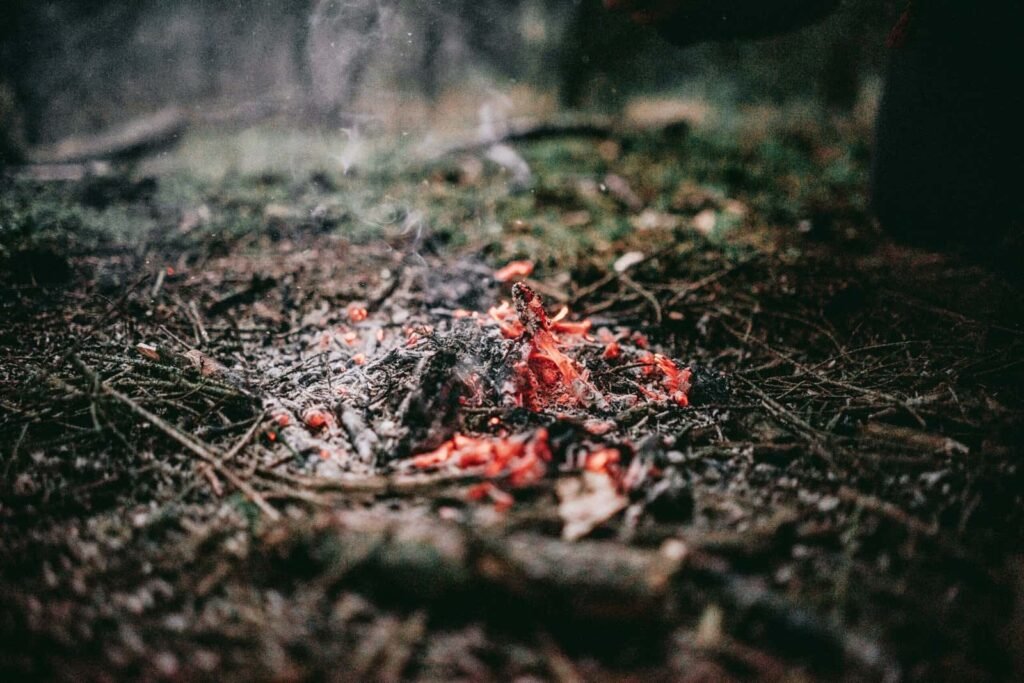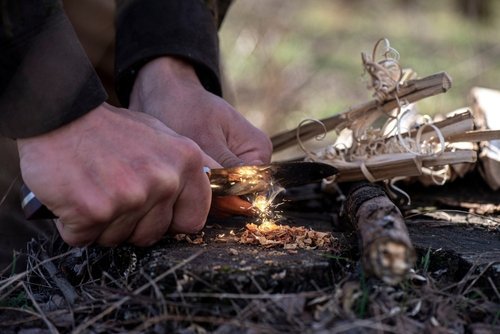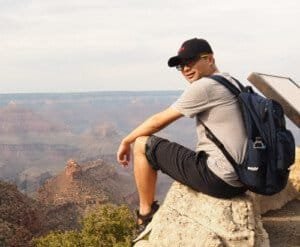Starting a fire without a lighter is a valuable skill for outdoor enthusiasts and survivalists. Whether you’re camping, hiking, or in an emergency situation, knowing alternative methods to ignite a fire can be crucial. There are several reliable techniques to start a fire using tools like a ferro rod, flint and steel, or even by harnessing the power of the sun. This guide will explore different methods to help you stay warm, cook food, and signal for help when you don’t have a lighter. With a little practice and the right materials, you can master the art of fire-starting in any condition.
How to Use Traditional Methods for Fire Starting
Using traditional methods for fire starting can be both fun and essential. Here are some classic techniques to ignite a fire without a modern lighter:
Ferro Rod:
- Scraping Sparks:A ferro rod is a reliable fire starter. Hold the rod close to your tinder and scrape it with a hard object like the back of a knife. The sparks produced will ignite the tinder.
- Choosing Tinder:Use dry leaves, grass, or small twigs as tinder. Make sure they are dry and fluffy to catch sparks easily.
Flint and Steel:
- Creating Sparks:Strike a piece of steel against a flint rock. This action produces sparks that can ignite your tinder.
- Tinder Preparation:Char cloth works well with flint and steel. Place the char cloth where the sparks will land, and then transfer the glowing ember to your main tinder.
Bow Drill:
- Friction Method:The bow drill is an ancient fire-starting technique. It uses friction to create heat and eventually a coal.
- Components:You need a bow, a spindle, a fireboard, and a socket. Rub the spindle against the fireboard using the bow to create friction and heat. Once a coal forms, transfer it to your tinder bundle and blow gently to ignite a flame.
Magnifying Glass:
- Harnessing Sunlight:On sunny days, a magnifying glass can focus sunlight onto a small point, creating enough heat to ignite tinder.
- Tinder Selection:Use dry, fine tinder like leaves or paper. Hold the magnifying glass so that the focused beam of sunlight is directed onto the tinder until it smolders and ignites.
Hand Drill:
- Friction Fire:The hand drill is similar to the bow drill but simpler. It requires spinning a wooden spindle between your palms against a fireboard to create friction.
- Spinning Technique:Roll the spindle quickly between your hands while pressing down into the fireboard. This creates heat and eventually a small ember that you can transfer to your tinder.
By practicing these traditional fire-starting methods, you can develop valuable survival skills. Knowing how to use a fire starter like a ferro rod or mastering the bow drill can be essential when you don’t have a lighter. With patience and practice, you can confidently start a fire using these time-tested techniques.

What ingredients are needed for a general Fire Starting
Starting a fire requires the right ingredients to ensure it ignites and burns well. Here are the essential components needed for general fire starting:
Tinder:
- Dry and Fluffy:Tinder is the initial material that catches the spark or flame from your fire starter. It should be dry and fluffy to ignite easily. Examples include dry leaves, grass, paper, cotton balls, or small twigs.
- Fine Material:The finer and more delicate the tinder, the easier it is to catch fire. Make sure to prepare your tinder by fluffing it up to increase its surface area.
Kindling:
- Small Sticks and Twigs:Kindling consists of small sticks and twigs that catch fire from the burning tinder. These pieces should be slightly larger than tinder but still small enough to ignite quickly.
- Dry Wood:Use dry wood for kindling to ensure it catches fire easily. Arrange the kindling in a teepee or crisscross pattern over the burning tinder to allow air to circulate.
Fuel:
- Larger Logs and Branches:Fuel wood consists of larger logs and branches that keep the fire burning for a longer time. Once the kindling is burning well, gradually add the fuel wood to maintain the fire.
- Dry and Seasoned:Ensure the fuel wood is dry and seasoned to burn efficiently. Wet or green wood can produce a lot of smoke and may be difficult to keep burning.
Fire Starter Tools:
- Ferro Rod or Flint and Steel:Use a reliable fire starter like a ferro rod or flint and steel to create sparks and ignite the tinder. These tools are durable and effective in various weather conditions.
- Magnifying Glass or Bow Drill:Alternative methods like a magnifying glass or bow drill can also be used to generate heat and ignite the tinder.
Oxygen:
- Airflow:A fire needs oxygen to burn. Ensure there is enough airflow around the fire by arranging the tinder, kindling, and fuel in a way that allows air to circulate. Blowing gently on the fire can help it grow.
Fire Pit or Safe Area:
- Containment:Create a safe area for your fire by building a fire pit or clearing a space free from flammable materials. This prevents the fire from spreading and ensures it stays controlled.
By gathering these ingredients and using a good fire starter, you can successfully start and maintain a fire. Practicing fire-starting techniques and understanding the importance of each component will help you stay prepared and confident in any outdoor or survival situation.
How to Use Chemical and Modern Methods for Fire Starting?
Using chemical and modern methods for fire starting can make the process easier and faster. Here are some effective techniques:
Chemical Fire Starters:
- Fire Starter Blocks:These are pre-made blocks or cubes soaked in flammable chemicals. Simply place one under your tinder and ignite it with a match or lighter. The block will burn steadily, helping to ignite the kindling and fuel.
- Gel Fire Starters:Gel fire starters are another chemical option. Squeeze a small amount of the gel onto your tinder, and light it with a match or lighter. The gel burns hot and long enough to get the fire going.
- Fire Paste:Similar to gel fire starters, fire paste can be smeared onto tinder or kindling. Light the paste, and it will produce a steady flame to ignite your fire.
Modern Fire Starters:
- Butane Lighters:Butane lighters are a convenient and reliable fire starter. They produce a steady flame with the click of a button. Some butane lighters are windproof, making them useful in various weather conditions.
- Electric Fire Starters:These devices use electricity to create heat or sparks. For example, an electric arc lighter produces a small, intense arc of electricity that can ignite tinder. These lighters are rechargeable and can be used many times.
- Matchsticks:Matches are a classic modern fire starter. Strike the match against the box to ignite it, then use the flame to light your tinder. Waterproof matches are available for use in wet conditions.
- Charcoal Chimney Starter:For starting a barbecue, a charcoal chimney starter can be very effective. Place crumpled newspaper or fire starter cubes in the bottom, fill the top with charcoal, and light the paper or cubes. The design allows for efficient airflow and quickly ignites the charcoal.
Pre-made Fire Starters:
- Wax-coated Cotton Balls:These are cotton balls dipped in wax, making them highly flammable. Light a wax-coated cotton ball with a match or lighter, and it will burn for several minutes, enough to start your fire.
- Compressed Sawdust Logs:These logs are made from compressed sawdust and wax. They are easy to light and burn for a long time, providing a reliable fire starter for campfires or fireplaces.
Using Accelerants:
- Caution:If you need to start a fire quickly, you can use accelerants like lighter fluid or gasoline. However, these should be used with extreme caution as they can cause flare-ups and are very dangerous.
- Application:Apply a small amount of the accelerant to your tinder and kindling, then light it with a match or lighter. Step back quickly to avoid the initial flare-up.
By using chemical and modern methods, you can make fire starting easier and more efficient. Whether you’re using a fire starter block, a butane lighter, or a wax-coated cotton ball, these tools can help you quickly and reliably ignite a fire. Practicing with these methods ensures you’re prepared for any situation where a fire is needed.

Safety precautions for start a fire without a lighter
Starting a fire without a lighter can be rewarding, but it’s important to follow safety precautions to ensure you and your surroundings stay safe. Here are some key safety tips when using a fire starter:
Choose a Safe Location:
- Clear Area:Ensure the area where you plan to start the fire is clear of flammable materials like dry grass, leaves, or overhanging branches. This helps prevent the fire from spreading.
- Fire Pit:Use a designated fire pit if available. If not, create a circle of stones to contain the fire and keep it controlled.
Prepare for Emergencies:
- Water Supply:Always have a bucket of water, sand, or a fire extinguisher nearby to quickly put out the fire if it gets out of control.
- Fire Blanket:Keep a fire blanket on hand to smother any flames that might spread unexpectedly.
Monitor the Fire:
- Never Leave Unattended:Never leave your fire unattended. Always have someone watching it to ensure it stays under control.
- Keep It Small:Keep the fire manageable. A large fire can quickly become uncontrollable, especially in windy conditions.
Using a Fire Starter:
- Proper Handling:When using a fire starter like a ferro rod, ensure you scrape away from your body to avoid injury. Hold the fire starter firmly and use controlled, deliberate strokes to produce sparks.
- Lighting Materials:Be cautious when lighting chemical fire starters or accelerants. Only use a small amount and stand back once you ignite it to avoid sudden flare-ups.
Wind Conditions:
- Wind Direction:Be aware of the wind direction. Position yourself so that the wind blows the sparks and flames away from you and any flammable materials.
- Wind Barriers:If it’s windy, create a barrier with rocks or logs to shield the fire from strong gusts that could spread it.
Extinguishing the Fire:
- Douse Thoroughly:When you’re done with the fire, extinguish it thoroughly. Pour water over the fire, stir the ashes, and pour more water until everything is cool to the touch.
- Check for Embers:Ensure there are no remaining embers that could reignite. Cover the area with dirt or sand to smother any hidden sparks.
Respect Fire Bans:
- Local Regulations:Always check local regulations and fire bans before starting a fire. In dry or windy conditions, authorities may prohibit fires to prevent wildfires.
- Compliance:Follow all rules and guidelines to ensure you are not putting yourself or others at risk.
By following these safety precautions, you can enjoy the benefits of starting a fire without a lighter while minimizing the risks. Being prepared and cautious ensures that your fire-starting experience is safe and enjoyable. Always prioritize safety to protect yourself and the environment.
What are the Practical Applications of Fire Starting
Knowing how to start a fire without a lighter has many practical applications, especially in outdoor and survival situations. Here are some key uses for a fire starter:
Camping:
- Cooking Food:A fire starter is essential for camping. You can use it to light a campfire for cooking meals, boiling water, and roasting marshmallows.
- Warmth:Starting a fire provides warmth, especially during cold nights. It helps you stay comfortable and prevents hypothermia.
Hiking and Backpacking:
- Emergency Situations:If you get lost or stranded, a fire starter can help you signal for help. The smoke and flames can attract attention from rescuers.
- Drying Clothes:Wet clothes can be uncomfortable and dangerous. Starting a fire allows you to dry your clothes and gear, keeping you warm and dry.
Survival Situations:
- Purifying Water:In a survival situation, you can use a fire starter to boil water, making it safe to drink by killing harmful bacteria and parasites.
- Cooking and Food Preservation:Fire enables you to cook food and preserve it through methods like smoking and drying, which extends its shelf life and ensures you have a reliable food source.
Emergency Preparedness:
- Power Outages:During power outages, a fire starter can help you light a fire for warmth, cooking, and lighting. It ensures you can maintain basic needs without electricity.
- Disaster Situations:In natural disasters, such as earthquakes or floods, having a fire starter in your emergency kit can be crucial for survival.
Outdoor Activities:
- Fishing and Hunting:A fire starter is useful for outdoor activities like fishing and hunting. You can cook your catch or game on the spot, ensuring you have fresh, hot meals.
- Social Gatherings:Campfires create a central place for socializing. They provide light, warmth, and a cozy atmosphere for telling stories, singing songs, and enjoying the company of friends and family.
Learning and Skill Development:
- Bushcraft Skills:Practicing fire starting enhances your bushcraft and survival skills. It teaches you how to use natural materials and tools to create fire in various conditions.
- Scout Training:Fire starting is a fundamental skill in scouting and outdoor education programs. It helps build confidence and self-reliance in young adventurers.
Understanding the practical applications of fire starting with a fire starter underscores its importance in outdoor adventures and emergency situations. By mastering this skill, you can ensure your safety, comfort, and survival in a variety of scenarios.

FAQ
Q1: What are some alternative methods to start a fire without a lighter?
A: You can use a ferro rod, flint and steel, a bow drill, a hand drill, a magnifying glass, or chemical fire starters to start a fire without a lighter.
Q2: How do you start a fire with a ferro rod?
A: To start a fire with a ferro rod, scrape the rod with a hard object like a knife to produce sparks. Aim the sparks at dry tinder until it ignites, then add kindling and larger wood to build the fire.
Q3: What is the best tinder to use when starting a fire without a lighter?
A: The best tinder includes dry leaves, grass, bark, paper, cotton balls coated in petroleum jelly, and small twigs. These materials catch sparks easily and ignite quickly.
Q4: Can you start a fire in wet conditions without a lighter?
A: Yes, you can start a fire in wet conditions using a ferro rod or chemical fire starters. Make sure to use dry tinder stored in a waterproof container and create a shelter to keep the fire area dry.
Q5: What safety precautions should I take when starting a fire without a lighter?
A: Choose a safe location, keep water or a fire extinguisher nearby, never leave the fire unattended, and fully extinguish the fire when done. Be cautious with wind direction and follow local fire regulations.
Q6: How can I start a fire using a magnifying glass?
A: To start a fire with a magnifying glass, focus sunlight onto a small, dry piece of tinder. Hold the magnifying glass steady until the tinder begins to smolder and then blow gently to ignite a flame.
Conclusion
Starting a fire without a lighter is a valuable skill for outdoor and emergency situations. Using methods like a ferro rod, flint and steel, or a bow drill ensures you can ignite a fire reliably. Practice these techniques and follow safety precautions to stay prepared and confident in any condition. For more information and to purchase high-quality fire starters, visit our product landing page.

